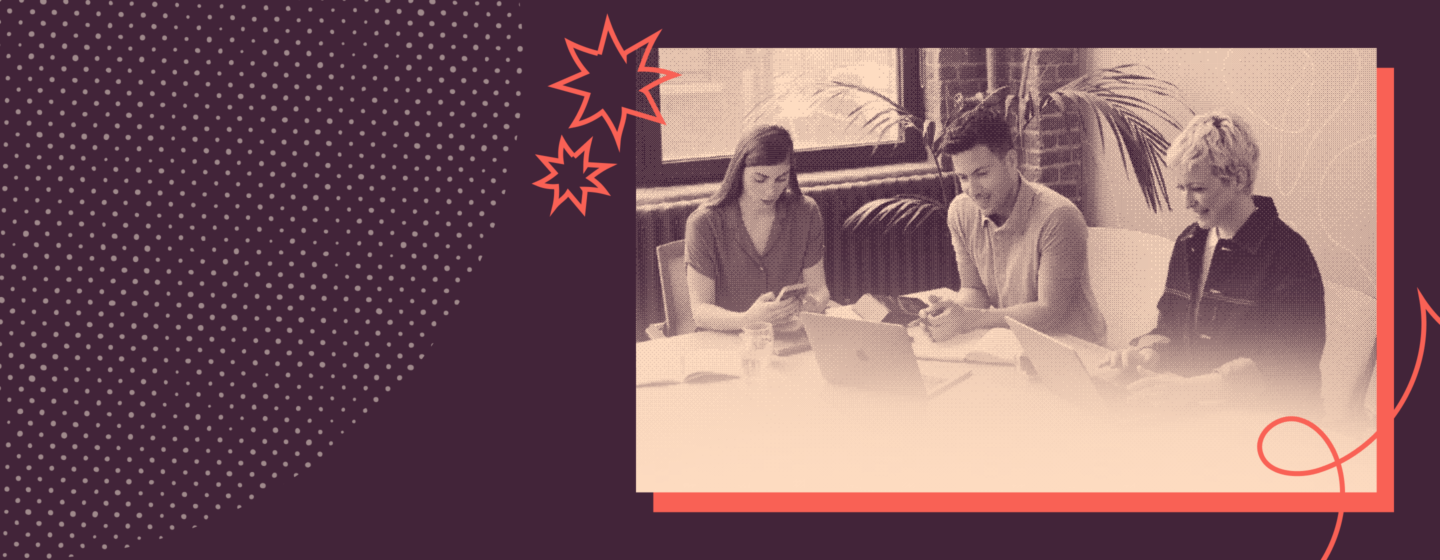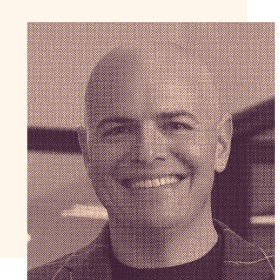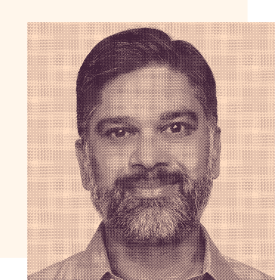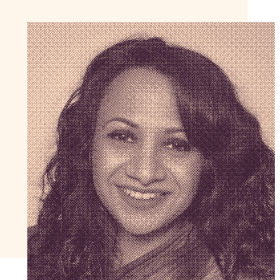
Reflections on the future of work
This article is an excerpt from Vibe: Inspiring people leadership. The second edition of the Zine focuses on engagement, retention, and profitability. Grab your copy.
It’s no secret that the world of work as we know it is evolving — and fast. During significant change, we often look to our leaders for guidance and support in anticipation of what’s to come. Earlier this year, the Josh Bersin Company, one of the leading authorities on corporate talent, learning, and HR technology, published a set of predictions for the world of work in 2023 and beyond. Here, they explored the directions in which the professional world will go and shared ways organizations can get ahead of the curve and lead their teams to success despite challenging times.
We turned to GSoft’s steadfast leadership members to hear their thoughts and points of view on these intriguing predictions from Josh Bersin. Read their takes on these hot topics, from productivity and recruitment to talent intelligence and performance management.
Leadership views on the current and future state of work
- People analytics will evolve into talent intelligence
- HR organizations will move to a new operating model: systemic HR
- Productivity will become an essential measure of employee success
- New models of performance management will take hold
- The role of recruiters is increasingly important
- Further reading to inspire people leaders
People analytics will evolve into talent intelligence
By Martin Gourdeau, General Manager
Efficiency vs. effectiveness is taught in most management studies but is unfortunately forgotten by many as soon as they enter the corporate world.
There are many reasons for this, but at the end of the day, it mostly comes down to the alignment of interests. Efficiency is fundamentally “profit-driven,” while effectiveness is a “checkmark” concept. The vast majority of employees are hired, reviewed, and promoted on “checkmarks.” Was X accomplished? Check. The presence of this phenomenon is, unfortunately, directly and linearly correlated to the size of the business.
However, now and then we witness a global turn of events that shifts the collective focus on efficiency. The brutal economic correction the tech industry went through in 2022 was one of the most drastic in recent history. The unprecedented cash injection from most of the central banks in developed countries, in response to projected COVID economic repercussions, led to years of abundant capital. But human nature kicks in; abundance can lead to complacency, and complacency means a broad focus on effectiveness vs. efficiency.
Want to grow into a new market? –> Hire.
Want to deliver an ambitious project? –> Hire more.
Meta roughly doubled its headcount between 2019 and 2022, while revenue was up about 65% during that same period.
So here we are. The music stops, and the pendulum swings the other way. The news is full of companies undergoing layoffs. The business elite has completely changed their narrative. All we hear about now is sustainability, strong fundamentals, unit economics, and free cash flow. Companies need to do the right things and do things the right way. It’s no surprise that a few engaged, clever, and complimentary A-players will outperform a team that is 5 or 10 times larger if that second team is dysfunctional.
What if you could engineer that first team consistently? Enter the next chapter in people analytics: talent intelligence.
“The most important asset in any company is people, and the technology to unlock their full potential will be invaluable moving forward.”
Martin Gourdeau

The macro-economic context has created a catalyst to fuel the next generation of HR tech landscapes. The most important asset in any company is people, and the technology to unlock their full potential will be invaluable moving forward. History shows us that technology isn’t a threat but an opportunity. Organizations that fully learn to leverage talent intelligence tools will have an unfair advantage over all the others. In this market, businesses should take all the unfair advantages they can get.
Insights into action
Without tools to help you measure and act, your employee experience falls behind. The best employee experience software not only enhances your employee experience but offers actionable insights as well.
Get executive buy-in for your employee experience tools by following the five steps outlined in our comprehensive Buyer’s Guide.
HR organizations will move to a new operating model: systemic HR
By Anaud Ganpaul, VP of Product
Traditionally, human resources leaders have been key players in addressing internal and external changes that drive and support their organization’s business strategies.
However, HR leaders and C-suite alike are recognizing that traditional siloed HR models no longer meet the demands of today’s workforce. They are now turning to a new operating model called systemic HR — a holistic approach to HR management that emphasizes how different HR processes impact overall business strategy.
This operating model involves:
- breaking down silos
- promoting cross-functional collaboration
- considering the entire employee lifecycle
- creating a seamless employee experience aligned with business goals
A key feature of systemic HR involves incorporating data-driven feedback and decision-making more efficiently with integrated strategies. This concept can benefit companies of all sizes but requires building a strong talent intelligence data and applications layer in their HR tech stack. Once implemented, a systemic HR model will provide feedback on these strategies’ effectiveness and can shed light on employee engagement, productivity, recognition, coaching, recruitment, skills, and help identify any learning gaps. Now that’s impressive!
“By leveraging this feedback, organizations can make informed decisions that drive better business outcomes.”
Anaud Ganpaul

Managing multiple software components to get employee feedback can take time for overextended HR teams, managers, and employees. Bersin has coined the term “mid-market talent intelligence suites” to recognize the new breed of software providers, like GSoft, that integrate these capabilities into a single platform. By leveraging this feedback, organizations can make informed decisions that drive better business outcomes.
Systemic HR represents a significant shift in how organizations operate. With this holistic approach, HR leaders can drive organizational success by aligning their strategies with business goals. By leveraging talent intelligence to focus on employee engagement, development, and performance and adopting modern HR technology, organizations can create a seamless employee experience that leads their businesses to success.
Insights into action
Setting efficient goals is essential to the success of any business. Lead your team to the finish line every time with clearly outlined objectives at the individual and organizational levels.
Productivity will become an essential measure of employee success
By Jean-Luc Brisebois, Chief Revenue Officer
Talking about productivity can often be uncomfortable for many managers; it can evoke images of the stereotypical evil businessperson putting the bottom line above all else. But in this current economic reality, dictated by stock markets and weakened by labor shortages, we must be more judicious when allocating our time and resources. We all need to do more with less, meaning productivity must take center stage.
“We all need to do more with less, meaning productivity must take center stage.”
Jean-Luc Brisebois

But there’s a line that can’t be crossed: while extra efforts will be required all around, you can’t just add more to people’s plates and expect great results. This is where the power of “no” comes into play; saying no to projects that fall lower on the list of urgencies to make room for initiatives with higher potential ROI.
To me, one of the most important steps a leader can take is to align your team around the notion that resources are limited. Engagement will skyrocket if you:
1. Are clear on your rationale around what needs to be put aside (and why).
2. Combine this with concrete data to prioritize initiatives.
At the end of the day, your team wants to know that their work contributes to the bigger picture. As leaders, we empower people to reach their objectives and guide them on their professional journeys to reach collective organization goals.
Insights into action
Even the highest-performing teams may hit productivity blockers. But equipping you and your managers with the right strategies to prevent and overcome them makes all the difference in the long run.
Learn how you can tackle the four most common roadblocks in the workplace.
New models of performance management will take hold
By Umbreen Tapal, Director, Product Management
HR leaders are facing a unique challenge; on the one hand, there is more pressure than ever from the C-suite to demonstrate how people management practices are enabling teams to deliver results and ultimately drive organizational performance. On the other hand, HR leaders must keep employees engaged in a tight labor market where you can’t hire your way out of a talent gap.
We’ve been spending a lot of time listening to and understanding the context of our customers. One of the key emerging themes is that although we’ve been talking about what is broken with traditional performance management for years, this moment feels like we are seeing a critical mass of organizations that are ready to move towards continuous and agile performance management.
“There is strong data indicating that high-performing organizations focus on goal alignment and clarity.”
Umbreen Tapal

Another key theme we keep hearing about (and this is closely linked to the company performance results that the C-suite is looking for) is organizational alignment around goals. Goals need to be adapted and adjusted in a fast-moving business context. So, we see enabling behaviors around reflection, adjustment, and alignment on team and individual goals as a critical thread that connects the new continuous performance and people development process.
This does not really come as a surprise as there is strong data indicating that high-performing organizations focus on goal alignment and clarity. When employees rally around common goals and have a clear vision of success, they are more likely to feel connected to their work and organization. Your employees must be motivated to reach collective goals to achieve high performance and satisfaction. Start prioritizing goal setting and regular progress check-ins and watch your retention rates soar.
Insights into action
Organizations that prioritize and actively work towards increasing employee engagement are proven to retain people who consistently do their best work.
Read on to learn more about why it pays to invest in your people.
The role of recruiters is increasingly important
By Jonathan Berlinski, Director, Talent Acquisition
Truly understanding what it takes to fill a role within an organization goes far beyond a list of skills in a job description: you must consider the managers’ needs, technical and soft skills, culture fit, etc. Finding great people is a challenging skill to duplicate with any tool or piece of technology.
Relationships and ambassadorship remain core to the recruitment function. It certainly helps to have an outstanding employer brand. Still, it takes skilled recruiters to:
- amplify that message,
- actively engaging with the right talent in the market at the right time,
- champion the brand, and
- provide a first-hand experience of what it is like to work within a truly great company.
Building a distinctive employer brand goes hand in hand with candidate experience. First impressions are lasting, and every touchpoint with a candidate is an opportunity to create a relationship. Fostering that experience is a little extra work, but it’s well worth the investment.
“Organizations need to support their recruiters by equipping them with the latest tools and technologies and helping them keep up with the latest trends.”
Jonathan Berlinski

I also think we’ll see internal mobility becoming a trend in 2023. As many companies look to scale down external recruiting in the current economic context, they will invest in the growth and upskilling of their employees. Internal talent mobility also provides external candidates with a clear message that opportunities for growth and progression exist within this company — a powerful recruiting tool and stance.
Organizations need to support their recruiters by equipping them with the latest tools and technologies and helping them keep up with the latest trends. It’s equally important for recruitment units to collaborate closely with other teams, such as legal, marketing, and HR, to maintain awareness of what’s happening within the organization. And make sure they’re in sync with company objectives.
Insights into action
In the age of digitization, constant change, and a cautious economic landscape, workforce planning is becoming mission-critical. No longer can leadership rely on guesstimates or instincts alone. They must adopt a new mindset that puts data (and the priorities it uncovers) over politics.
Learn more about the future of workforce planning and what to use to make data-driven decisions.
Further reading to inspire people leaders
The workplace has seen fundamental changes over the last several years. And there are no signs that it’s slowing down. But change can be profoundly cathartic. It can even act as the catalyst for resiliency and growth during disruptive times.
The second edition of VIBE: Inspiring people leadership aims to lift the fog on how HR teams can boost their people strategy by supporting their managers. It features thought leadership articles like this one, tips on how HR practitioners can strengthen engagement and improve employee retention, a look at the real cost of turnover (and how you can prevent it), and much more. Grab your copy and learn more about the deep connections between engagement, retention, and profitability.
Would you be interested in receiving our newsletter directly in your inbox?
